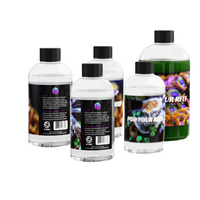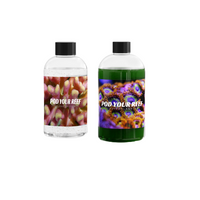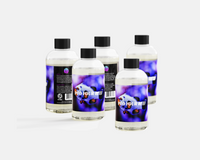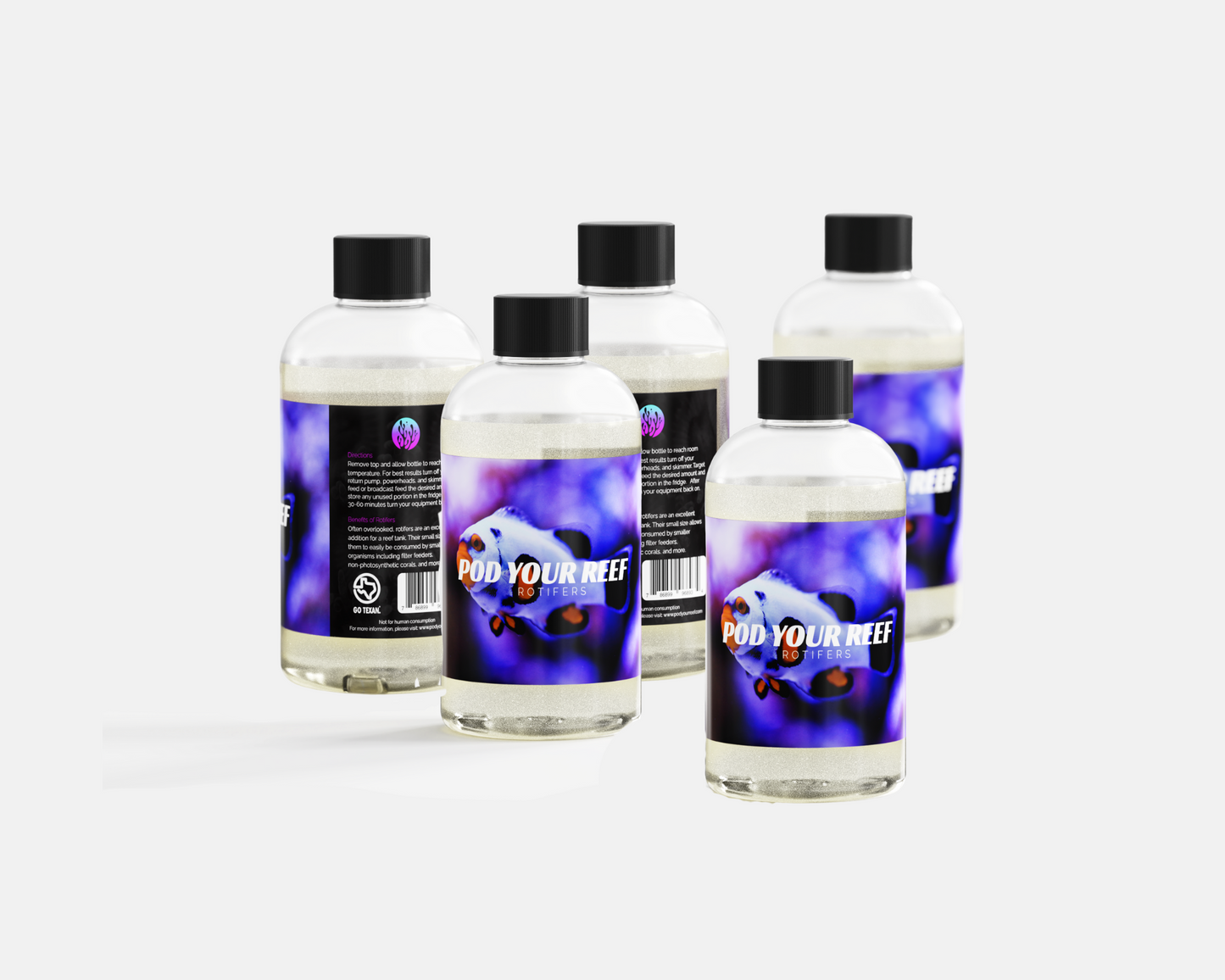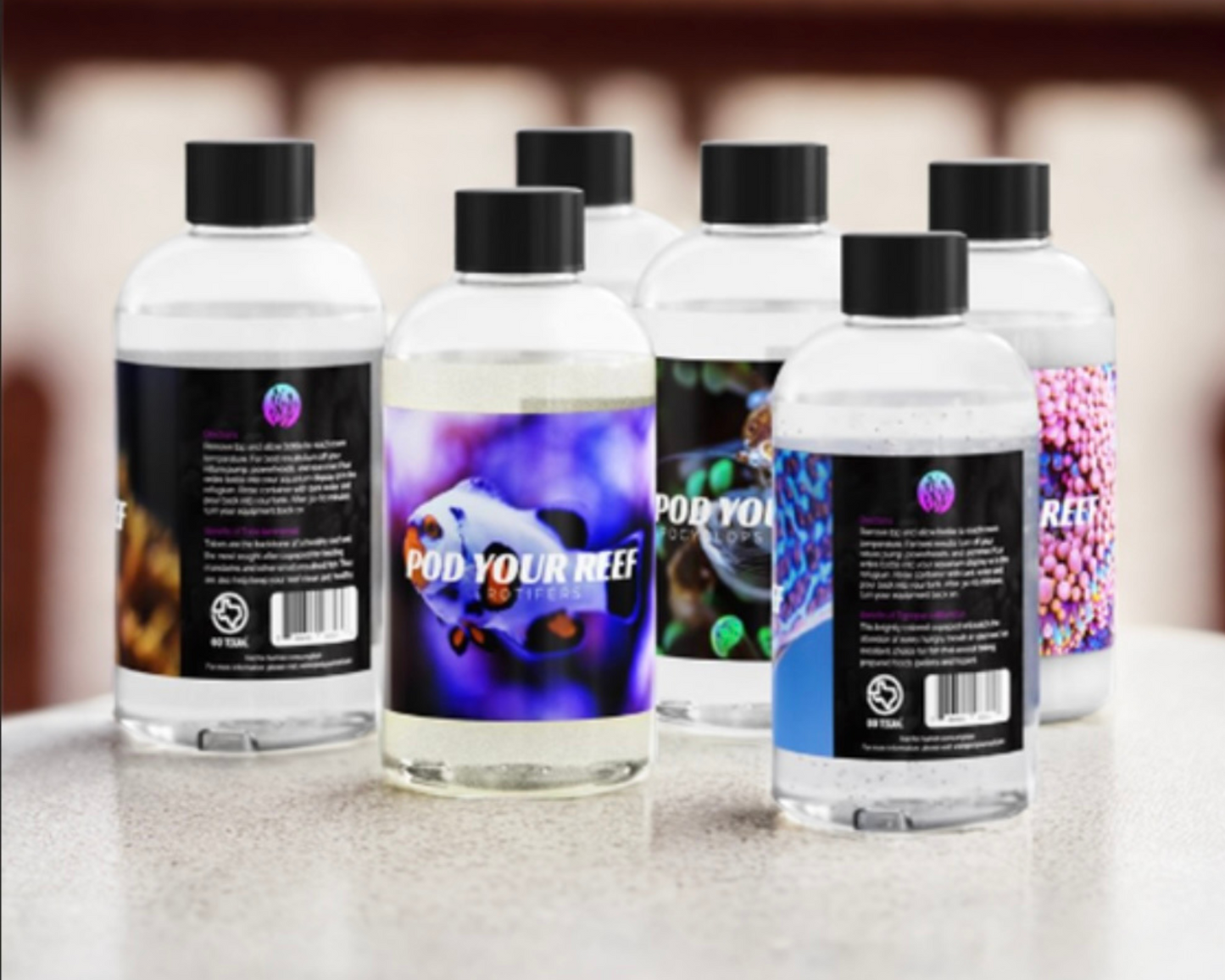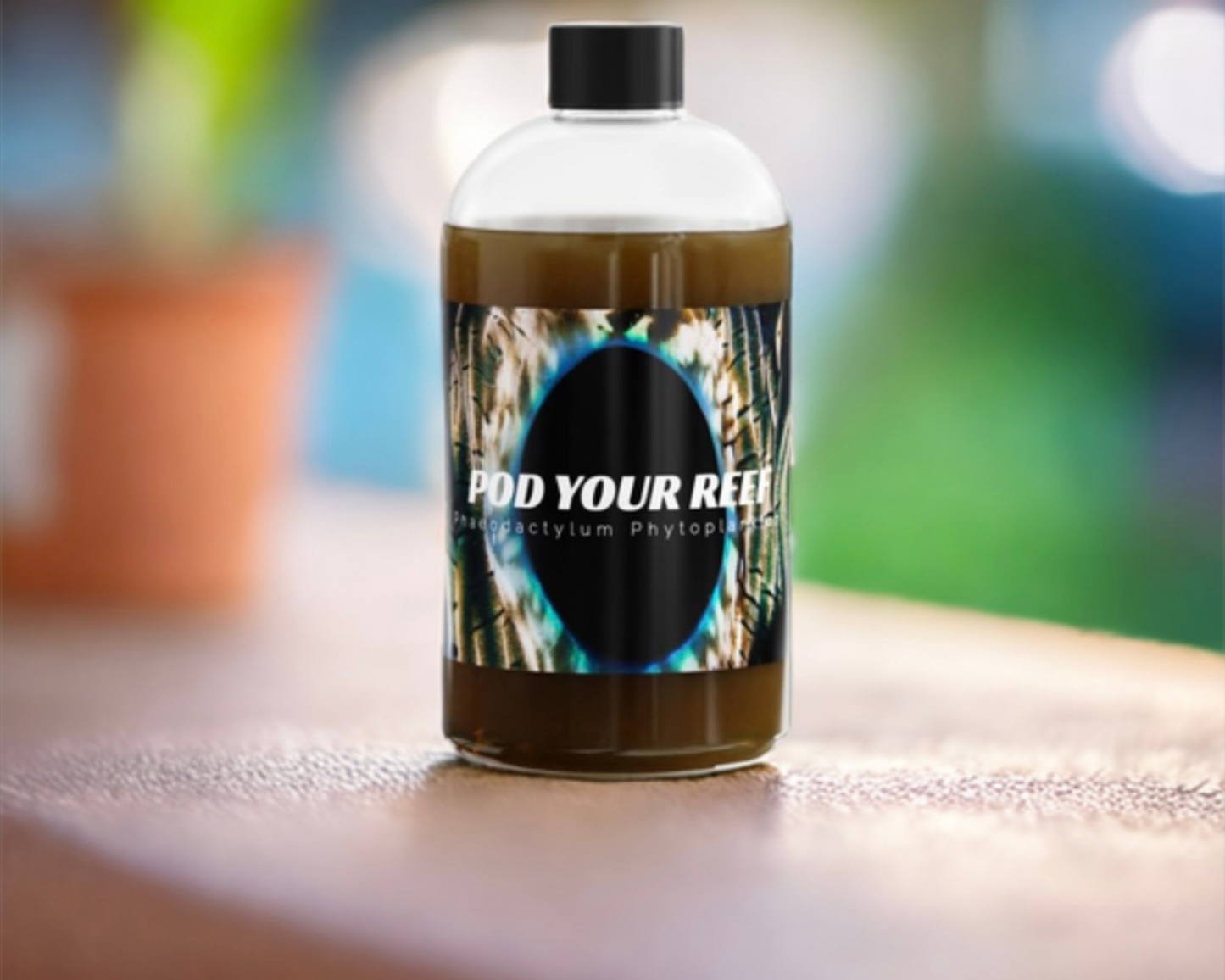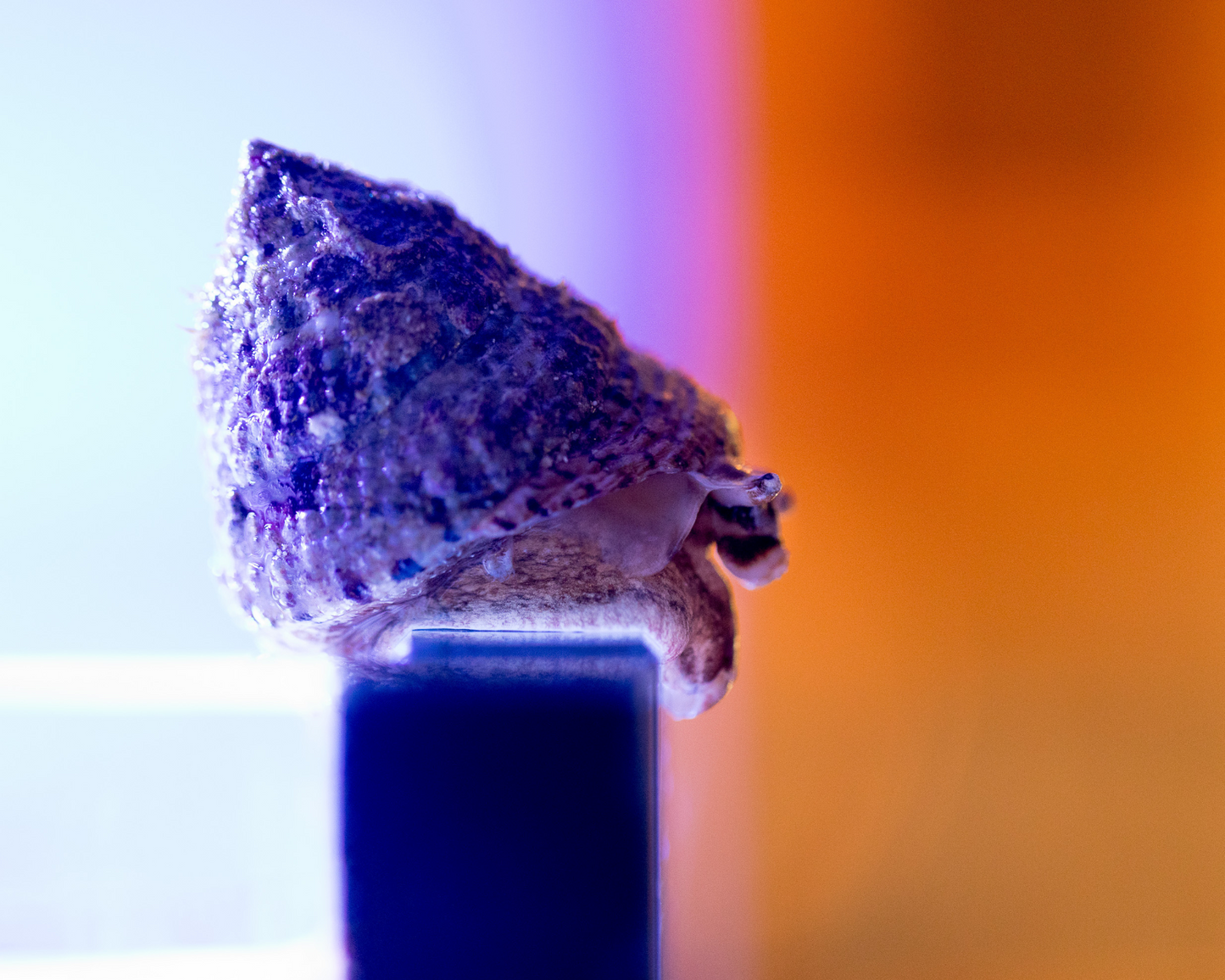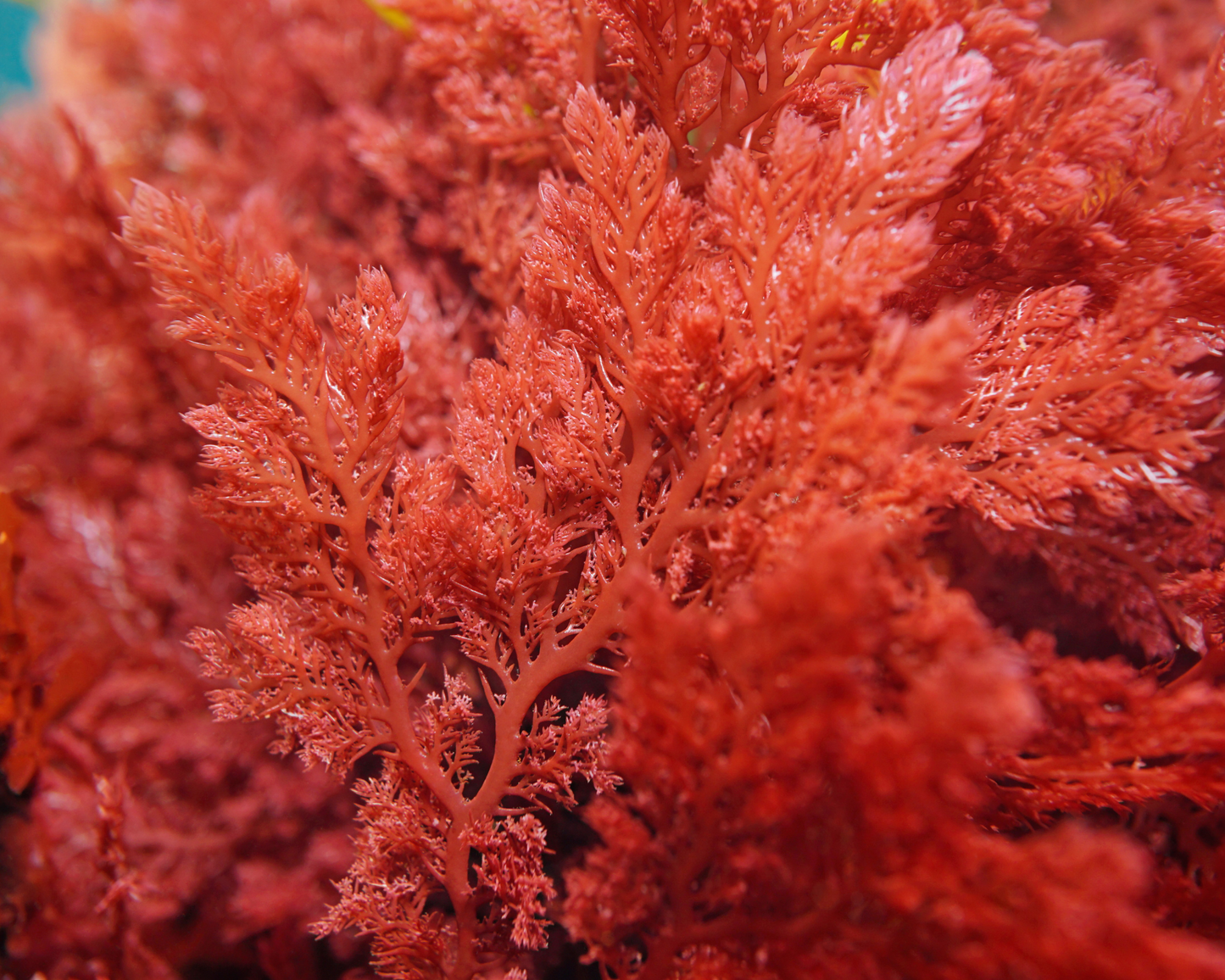Save $10

Tisbe biminiensis – The Ultimate Reef Copepod for Coral and Fish Nutrition
Advanced reef hobbyists and marine researchers are increasingly recognizing Tisbe biminiensis as a cornerstone of reef tank microfauna. This tiny crustacean – a species of harpacticoid copepod – offers a potent combination of rapid reproduction, rich nutrition, and natural cleaning behavior that benefits both corals and fish. In this comprehensive guide, we delve into the natural history, habitat, diet, and unique biological traits of Tisbe biminiensis. We’ll also compare it to other popular aquarium copepods (like Apocyclops panamensis and Tigriopus californicus), and explore why its size and lifestyle make it ideal live food and environmental enrichment in reef aquaria. Whether you’re seeding a new refugium or boosting food for delicate feeders, Tisbe pods could be the “jewel” of your reef ecosystem. Let’s dive into everything you need to know about this remarkable copepod.
Natural History and Taxonomy of Tisbe biminiensis
Tisbe biminiensis is a harpacticoid copepod in the family Tisbidae, first described by Volkmann-Rocco in 1973. In the broader taxonomy of crustaceans, it falls under Class Maxillopoda (Subclass Copepoda) and Order Harpacticoida, meaning it’s part of the diverse group of copepods commonly found in marine environments. Harpacticoid copepods like Tisbe are generally benthic (bottom-dwelling) in habit, as opposed to free-swimming planktonic copepods. Indeed, T. biminiensis spends its adult life crawling on surfaces in the reef, which has earned it a reputation as a “stealthy substrate crawler” in aquariums.
In terms of natural history, Tisbe biminiensis is tropical in origin, with the species name likely referencing Bimini in the Bahamas, where it was first identified. However, it has a wide distribution across tropical and subtropical regions. Over time it has become so ubiquitous that pinpointing an exact native range is difficult. These copepods thrive in shallow coastal ecosystems, both oceanic and estuarine, provided the salinity stays above about 20 ppt (they rarely survive below that). In the wild, they are often found on sandy or rocky bottoms, amongst macroalgae, seagrasses, or coral rubble, where they graze on biofilm and detritus. This species was one of the first harpacticoids studied for aquaculture, and for good reason – its adaptability and prolific nature make it a model organism for both laboratory research and practical aquaculture.
From a classification perspective, one might summarize Tisbe biminiensis as follows:
- Kingdom: Animalia
- Phylum: Arthropoda (Subphylum Crustacea)
- Class: Maxillopoda (Subclass Copepoda)
- Order: Harpacticoida
- Family: Tisbidae
- Genus: Tisbe
- Species: Tisbe biminiensis (Volkmann-Rocco, 1973)
This copepod does not have widely used common names, but aquarists often simply refer to it as “Tisbe pods” or Tisbe copepods. It is arguably the most recognized copepod species in the reef aquarium hobby due to its usefulness. Next, we’ll explore where these pods are found and the conditions they call home.
Native Habitat and Global Distribution
In the wild, Tisbe biminiensis occupies tropical and subtropical marine habitats around the world. It has been documented in the Caribbean and Western Atlantic (as its name implies), but also appears in other warm seas, suggesting a cosmopolitan distribution in warm waters. Because it tolerates a range of conditions, Tisbe may be present in many coastal regions with suitable temperatures. These copepods are often epifaunal, meaning they live on the surface of sediments or other substrates. Divers and researchers have found Tisbe “carpeting” seafloor sediments, especially in nutrient-rich areas like seagrass beds and reef flats where detritus and microalgae accumulate.
Typical Tisbe biminiensis habitat includes shallow lagoons, coral reef zones, and mangrove shallows. They thrive among live rock, sand, and macroalgae. In fact, in reef aquaria they are known to stay low in the rockwork and substrate, similar to how they behave in nature. Being benthic, they crawl through cracks and crevices, grazing as they go. This lifestyle protects them from some predators in open water and mimics their natural niche on reefs, where hiding in crevices keeps them safe from fish while they feed.
Interestingly, Tisbe biminiensis can handle moderately brackish conditions (estuaries) as well as full-strength seawater, demonstrating euryhaline capability. However, their reproductive rate tends to be highest at full ocean salinities (~1.025–1.030 specific gravity, equivalent to 33–40 ppt). They also prefer warmer temperatures; studies have shown their development and breeding speed up as temperatures rise (up to around 25°C or 77°F). In tropical climates or typical reef tank temperatures (24–27°C), Tisbe can complete life cycles very quickly.
In summary, Tisbe biminiensis is native to warm, shallow marine environments worldwide. Its ideal conditions are warm water, marine salinity, plenty of surface area (sand, rock, algae) to colonize, and a good supply of organic matter or microalgae to eat. These conditions are easily replicated in reef tanks, which is why Tisbe adapts so readily to captive systems. In fact, aquarists often culture these copepods in dedicated refugia or even within the display tank. Next, we’ll look at what Tisbe biminiensis eats and how it feeds in both nature and aquaria.
Diet and Feeding Behaviors
One reason Tisbe biminiensis is so valued in reef ecosystems is its role as a generalist grazer and detritivore. In the wild (and in your tank), Tisbe copepods feed on a smorgasbord of tiny food items: microalgae, diatom films, bacterial biofilms, detritus (organic waste), and even bits of leftover fish food or fish waste. Essentially, if it’s a small organic particle or microbial growth, Tisbe will scrape it up and eat it. This broad diet means they help recycle waste into biomass, acting as part of the “cleanup crew.”
Tisbe biminiensis has specialized mandibles adapted to scrape biofilms off surfaces. Under the microscope, you can see these copepods rasping away at the thin layers of algae and bacteria that accumulate on glass and rocks. In fact, Tisbe shows a particular fondness for diatom algae films, which often appear as brown patches on aquarium glass and rocks. Diatoms are rich in pigments and “golden” fatty acids, making them especially nutritious, and Tisbe instincts seem to guide it to these high-value foods.
Being a benthic species, adult Tisbe spend most of their time crawling on hard surfaces or substrate while feeding. They methodically scour the nooks and crannies of live rock, sand grains, and macroalgae fronds. This behavior not only nourishes the copepods but also cleans the aquarium by removing film algae and detritus that would otherwise accumulate. As they graze, Tisbe improve water quality by preventing excess waste build-up and even increasing oxygen penetration into the substrate (because their grazing clears out clogged detritus).
Interestingly, studies have shown that T. biminiensis prefers settled (benthic) food over suspended food. In one experiment (Araujo-Castro et al. 2005), adult Tisbe consumed benthic algae and detritus in favor of free-floating phytoplankton in the water. This means in an aquarium they will focus on cleaning surfaces and the sandbed, rather than competing with truly planktonic feeders for food in the water column. That said, Tisbe nauplii (the larval stages) are planktonic and will feed on microalgae in the water when they first hatch. Diet can influence their development and reproduction – offering a mix of nutritious phytoplankton (including diatoms like Thalassiosira) yields larger and more productive Tisbe populations.
In summary, Tisbe biminiensis will eat almost any organic material it can handle:
- Microalgae: e.g. diatoms, film algae, phytoplankton cells
- Bacterial films: the slimy biofilm on live rock and glass
- Detritus: decaying plant matter, fish waste, and other detrital particles
- Leftover food: tiny fragments of fish food or coral food that sink into rock crevices
- Protozoans or fungi: occasionally, as part of detritus/biofilm mix
This omnivorous grazing makes Tisbe incredibly useful in aquariums. They are nature’s little janitors, converting muck into something beneficial (themselves!). Next, we’ll examine how these copepods move and utilize energy – key to understanding how they evade predators and find food.
Movement Mechanisms and Energy Utilization
Despite their microscopic size, Tisbe biminiensis are surprisingly mobile. How do these copepods move? As larvae (nauplii), they are free-swimming; as adults, they predominantly crawl but can also swim in short bursts. This two-phase locomotion is typical of harpacticoid copepods.
In the early nauplius stage, Tisbe hatch as tiny (50–75 µm) six-legged larvae that propel themselves through the water column. They use rhythmic strokes of their appendages to swim – albeit in a somewhat jerky, zigzag fashion common to copepods. Nauplii have a planktonic lifestyle, drifting and feeding in the water. This movement is fueled by yolk reserves initially, and soon by the energy obtained from consuming microalgae. The nauplii don’t travel far on purpose, but they stay suspended, which has an important ecological role: nauplii become part of the plankton, serving as food for filter-feeders like coral polyps (more on that later).
After passing through several intermediate stages (copepodites), Tisbe metamorphose into the adult form. Adult Tisbe biminiensis are benthic and mainly crawl. They cling to surfaces with specialized appendages and walk much like an insect on a surface – using their antennae and thoracic legs to grab and push. If startled or needing to relocate, they can perform a quick “scoot” or jump into the water column by flicking their body. This scooting locomotion is short-lived; usually the copepod will settle back onto a surface after a brief swim. Nevertheless, these periodic forays into open water help Tisbe spread to new areas or escape local threats.
The ability to alternate between clinging and free-swimming gives Tisbe an advantage in a reef tank. They can stick to the substrate to avoid being swept away by strong currents or getting eaten by fish, yet if needed they can disperse by letting go and riding the water flow. Aquarists often observe that when Tisbe populations boom, many adults end up on the aquarium glass or floating around – likely because overcrowding pushes some into the open water. This is when fish in the display take notice and snap them up.
From an energy utilization perspective, Tisbe biminiensis is highly efficient. It fuels its crawling and reproductive endeavors with the energy gleaned from low-quality detritus and biofilms. Remarkably, Tisbe can convert poor nutritional inputs into high-value energy stores. We’ll discuss this more in the nutritional profile section, but in brief: Tisbe have enzymes that allow them to synthesize essential fatty acids (like DHA and EPA) even when those are lacking in their diet. This means the copepod can utilize the energy from, say, decaying plant matter or even baker’s yeast, and upgrade it into superior fuel in its body. That fuel supports its active lifestyle (constant grazing and crawling) and its prodigious reproduction.
One interesting trait is that adult Tisbe are negatively phototactic, meaning they avoid light. They tend to hide in darker zones (under rocks, deep in refugia, or in filter media). This behavior likely evolved to help them evade visual predators and UV exposure. In practical terms, Tisbe pods expend energy foraging in the safe darkness and usually only venture into illuminated areas (like open sand or glass front) when populations are dense or food draws them there. When they do come into the light, they often become a meal for fish – effectively transferring that stored energy up the food chain.
In summary, Tisbe biminiensis moves primarily by crawling on surfaces, with occasional swimming bursts. It efficiently uses energy from whatever it eats, even poor-quality detritus, to sustain its rapid movements and fast breeding. By hiding in crevices and the dark, it conserves itself (avoiding predation) until it inevitably becomes food for something bigger. Now, let’s look at just how big (or small) Tisbe is, and why its size matters.
Average and Maximum Size of Tisbe biminiensis
Tisbe biminiensis is minute – even by copepod standards. For reef aquarists used to seeing “pods” on the tank glass, Tisbe may appear as tiny white specks or nearly invisible without magnification. So, how big do Tisbe pods get?
- Nauplius (larval) size: ~50–75 µm (micrometers) in length. That’s about 0.05–0.08 mm – truly microscopic. At this stage they are barely discernible as moving dots under a microscope. These nauplii are among the smallest live foods available, which is why they’re excellent for feeding coral polyps and larval fish.
- Adult size: approximately 0.5 to 0.75 mm in length on average. In older literature, adults were sometimes reported up to ~0.87 mm (females) including tail setae. Generally, under 1 mm is the norm. To put it in perspective, a fully grown Tisbe adult might be about the size of a pinhead or a grain of salt. Females carrying eggs appear larger/bulkier (because of their egg sac), while males are at the smaller end of the range.
- Maximum size: In ideal conditions, some Tisbe individuals might approach ~1 mm. Indeed, aquarium retailers list adult Tisbe in the 500–1000 µm range (0.5–1.0 mm). It’s worth noting that some misprinted info exists (one source erroneously cited adults as “40–60 microns” which is far too small). The consensus is that Tisbe biminiensis adults max out around 1 mm, with most being ~0.5 mm.
Within that tiny body, female Tisbe often carry a single egg sac almost as big as themselves! A brooding female has a cluster of dozens of eggs attached to her – a noticeable dark mass nearly equal to her body length. This reproductive burden is one reason females can appear larger or more rounded than males.
The small size of Tisbe biminiensis is a key advantage for reef tank use. Because they are so small at all life stages, they can be eaten by a wide range of tank inhabitants. Coral polyps and filter feeders can capture the free-swimming nauplii with ease, while small fish (such as mandarins, dragonets, pipefish, and fry of other fish) relish the adult and juvenile Tisbe that roam the rocks. Larger copepod species (like Tigriopus californicus, which can reach 2 mm) might be too big for some small-mouthed fish or coral, but Tisbe is “bite-size” for almost everyone.
Additionally, their diminutive stature means Tisbe can infiltrate tight spaces in the aquarium – deep into rock pores and dense macroalgae clumps – which both protects them and allows them to clean out detritus in those hidden zones. They are effectively scaling the microscopic terrain of your live rock, doing housekeeping where snails and crabs can’t reach.
To recap: an adult Tisbe biminiensis is usually around half a millimeter long, with the absolute largest individuals around one millimeter. This tiny size is perfectly suited to reef tanks, enabling Tisbe to serve as a ubiquitous prey item and efficient detritivore. Now that we know how small they are, let’s talk about the big nutritional punch these little pods pack – and why that matters for the health of your fish and corals.
Nutritional Profile and Role in Marine Fish & Coral Health
Despite their unassuming size, Tisbe biminiensis copepods are often described as “little food packets” rich in nutrition. They are, in essence, living multivitamins for reef inhabitants. Let’s break down the key aspects of their nutritional profile:
- High Protein Content: Like many zooplankton, Tisbe are rich in protein. Estimates from aquaculture sources indicate Tisbe biomass is roughly 40–50% protein by dry weight. This protein includes essential amino acids needed by fish for growth and by corals (which can consume zooplankton) for tissue building. Feeding on Tisbe gives fish a lean, protein-rich diet, which is especially important for larvae and juvenile fish that are building body mass rapidly.
- Rich in Lipids (Fatty Acids): Tisbe biminiensis truly stands out for its lipid profile. These copepods have exceptionally high levels of essential fatty acids (EFAs), including the all-important long-chain omega-3s DHA (docosahexaenoic acid) and EPA (eicosapentaenoic acid). Scientific studies and observations report that Tisbe contains abundant DHA, EPA, and also ARA (arachidonic acid, an omega-6 fatty acid). These “golden fats” are crucial for marine fish and invertebrates – they support proper growth, neurological development, cell membrane health, and enhance stress resistance and coloration. Many captive-bred marine fish suffer if their diet lacks DHA/EPA (for example, these fats are one reason wild zooplankton is superior to brine shrimp). Tisbe effectively packages these fatty acids into a convenient form for predators to consume.
- Unique Ability to Synthesize HUFAs: Perhaps most fascinating, Tisbe biminiensis can biosynthesize some of these crucial fatty acids on its own. Researchers have found that Tisbe maintain high levels of DHA, EPA, and ARA regardless of their diet – implying they have enzymes to convert simpler fats into these complex ones. In other words, even if Tisbe eats “junk” (like low-quality detritus), it can manufacture the valuable HUFAs (highly unsaturated fatty acids) that fish and corals need. This is a huge boon in a closed aquarium: Tisbe can convert waste and basic foods into super-nutritious prey. When a fish eats Tisbe, it’s not just getting the calories – it’s getting a dose of vitamins, EFAs, and even digestive enzymes (contained in the copepod’s gut).
- Vitamins and Pigments: Copepods are known to concentrate vitamins (like some B vitamins) and pigments from their food. Tisbe grazing on microalgae will accumulate carotenoids and xanthophylls (pigments), which then provide nutritional and color benefits to whatever eats them. Tigriopus copepods are famous for astaxanthin (a red pigment), but Tisbe too can contribute to fish coloration and health via pigments – especially if fed on mixed phyto including Isochrysis or Tetraselmis that contain carotenoids.
- Digestive Enzymes and Probiotics: Something not often considered in nutrition is that live prey like Tisbe come with “extras” that prepared feeds lack. Studies have shown Tisbe biminiensis produce proteases (protein-digesting enzymes) in their midgut, and when predators eat them, these enzymes can aid the predator’s digestion. This is particularly beneficial for larval fish that have developing digestive systems – essentially, Tisbe supply an external digestive boost. Additionally, the copepod’s gut contains useful microbes (probiotics) and vitamins that remain intact until consumed. All of this means that feeding live Tisbe can improve nutrient absorption and gut health of reef fish and coral that consume them.
In practical terms, what does this nutritional richness mean for your reef tank? Here are some key benefits:
- Enhanced Fish Health & Growth: Fish that feed on Tisbe get a complete diet: high protein for muscle, essential fats for immune function and growth, and enzymes/vitamins for digestion. Hobbyists breeding mandarins or raising marine fry often report better growth and survival when copepods are included as a first food, as opposed to rotifers or Artemia alone. For instance, experiments with fish larvae (like Dover sole and clownfish) showed improved growth, survival, and even pigmentation when Tisbe copepods supplemented or replaced traditional feeds.
- Coral and Invertebrate Nutrition: Many corals, especially small-polyp stony (SPS) corals, derive significant nutrition from capturing zooplankton. Tisbe nauplii are an ideal size for even tiny coral polyps to ingest. The rich fatty acids and amino acids in Tisbe can boost coral tissue growth and coloration. In fact, feeding corals with live copepods is akin to what they’d eat on wild reefs at night. Filter-feeding inverts (feather duster worms, certain clams, etc.) also benefit from Tisbe nauplii in the water column.
- Natural Feeding Stimulations: Live Tisbe triggers strong feeding responses. Finicky fish that often reject prepared foods (e.g. wild-caught mandarin dragonets, seahorses, certain wrasses) will actively hunt copepods. This ensures they receive nutrition and reduces the risk of starvation in species that might otherwise waste away in captivity. For corals, the capture of live prey can increase polyp extension and overall vigor.
- Continuous Enrichment: Since Tisbe can sustain itself by eating detritus in the tank, they essentially turn waste into food. They are little “nutrition factories,” upgrading leftover fish poop and microbe scum into lipid-rich snacks for your livestock. This ongoing process means even between your target feedings, Tisbe are at work improving the nutritional availability in the ecosystem.
Given this remarkable nutritional profile, it’s no surprise that Tisbe biminiensis is considered “nothing short of ideal” as a live food source in reef tanks. Now, we’ll discuss how their size and mobility (the traits we covered above) contribute to making Tisbe so useful in aquariums – both as prey and as part of the environment.
Ideal Size and Mobility for Reef Tanks (Food and Enrichment)
The small size and motile behavior of Tisbe biminiensis combine to make it practically perfect for reef aquarium purposes. Let’s break down why these traits are advantageous:
- Accessible to a Wide Range of Predators: Because adult Tisbe are <1 mm and juveniles are even smaller, they can be eaten by creatures of all sizes. Tiny fish fry and coral polyps can eat the smallest Tisbe stages, while larger fish like mandarins or wrasses can munch on adults. In a reef tank, this means Tisbe provides a “buffet” that everyone can partake in. Contrast this with larger pods (some copepods or amphipods reach several millimeters) which only bigger fish can eat. Tisbe ensures even the smallest, most delicate feeders get a meal. For example, a filter-feeding gorgonian coral can catch Tisbe nauplii, and a picky mandarin dragonet can graze all day on Tisbe adults hiding in the rocks – both benefiting from the same Tisbe population.
- Natural Behavior = Environmental Enrichment: Tisbe are constantly on the move – crawling over rock and sand, reproducing, darting away from danger. This activity provides environmental enrichment in the tank. Fish that naturally hunt for microcrustaceans (like many wrasses, dragonets, gobies, and seahorses) get to engage in their instinctual foraging behavior. A mandarin dragonet, for instance, will methodically peck at rocks all day, snagging Tisbe pods. Having a thriving Tisbe population lets such fish “work for their food” in a naturalistic way, which is great for their mental and physical health. It’s often observed that mandarins kept in tanks with ample live copepods maintain better body weight and activity levels.
- Self-Sustaining Food Source: Unlike many live foods that must be added repeatedly, Tisbe biminiensis can establish a breeding population in the aquarium. In a refugium (or even in the main display if there are safe zones free from predation), Tisbe will continuously reproduce. Each female can have ~8–10 broods in her lifetime, producing dozens of offspring per brood. With their short generation time (sexual maturity in about a week), populations can multiply quickly. This means once you seed your tank or refugium with Tisbe, they often maintain themselves – providing ongoing enrichment and nutrition without constant re-introduction. As long as some hiding spots exist (like a pile of rubble or macroalgae where fish can’t eat them all), Tisbe will replenish their numbers. Aquarists have found that Tisbe “quietly establish a stable population” in low-flow refugium zones or deep rockwork given the chance.
- Low-Risk, High Reward Feeding: Because Tisbe stay mostly on surfaces and come out at night (being nocturnal/photophobic), they aren’t as quickly decimated in the display tank by day-active fish. They hide and breed in the crannies, then some venture out regularly as a renewable snack. This dynamic ensures a continuous low-density presence of live prey – an ideal scenario for reef tanks. It’s the equivalent of having a bird feeder that refills itself. From the fish’s perspective, it’s an “endless supply” of food as long as the base population (usually in the refugium or sump) is protected and fed phytoplankton to keep breeding.
- Cleanup Crew Benefits: Don’t forget, while they’re alive in the tank, Tisbe are doing janitorial work. Their mobility allows them to find and consume bits of waste in places your cleanup crew (snails, crabs, etc.) might miss. They can get into tiny pores and under coral bases to eat decomposing matter, preventing rot and algae blooms. So, their presence enriches the environment not just as food, but as maintenance crew, contributing to a healthier, cleaner habitat for all.
In essence, Tisbe biminiensis hits a sweet spot: small enough to be eaten by almost anything, but hardy and prolific enough to sustain a population under predation. This makes them arguably the best all-around copepod for reef tanks. Aquarists often call Tisbe “the ultimate copepod” for seeding tanks, precisely because once established, they continually feed the system.
But how does Tisbe compare to other copepods available to hobbyists? Let’s compare it to two other common live copepod species: Apocyclops panamensis and Tigriopus californicus, which are also frequently used in reef aquaria.
Comparing Tisbe to Other Copepods (Apocyclops vs. Tigriopus)
Reef keepers have a few choices when it comes to live copepods. The three most popular species in the trade are: Tisbe biminiensis, Apocyclops panamensis, and Tigriopus californicus. Each has its own strengths.
· Tisbe biminiensis (Harpacticoid) – “The Stealthy Substrate Crawler”
Size: Smallest of the three. Adults ~0.5–1 mm; nauplii ~50 µm.
Behavior: Benthic crawler. Hides in rockwork, sand, macroalgae; mostly nocturnal/crepuscular activity.
Reproduction: Extremely prolific and fast-breeding, especially at reef temps (>25°C) and full salinity. Short life cycle (~2–4 weeks) with many offspring per female.
Diet: Generalist detritivore (prefers settled detritus and benthic algae). Grazes biofilm and surface algae, less on free-floating phyto (though will consume phyto in culture).
Aquarium role: Excellent micro-cleaner and constant food source. Best for sustaining populations in refugium or display long-term. Feeds small fish, coral polyps, filter feeders. Thrives in crevices – “background” pod that maintains itself.
Notable: Can convert poor diet to rich nutrition (synthesizes fatty acids). Soft-bodied, no spines – entirely edible at all stages. Tolerant of wide salinity (down to ~1.020) but prefers ~1.025–1.030.
· Apocyclops panamensis (Cyclopoid) – “The Midwater Cycler”
Size: Intermediate. Adults ~0.5–1.5 mm (between Tisbe and Tigriopus in size). Nauplii are small, similar to Tisbe’s.
Behavior: Semi-benthic, semi-planktonic. Adults split time between crawling on surfaces and swimming through the water column. Tend to be more active swimmers than Tisbe, doing short forays upward to feed.
Reproduction: High reproductive rate (cyclopoids generally breed fast). Apocyclops produces egg sacs; reproduction is rapid, though some strains prefer lower salinity (~1.015–1.020) for optimal breeding. Still, they survive and breed in reef salinity (euryhaline). They can quickly colonize a tank but may not sustain as densely if salinity is at the high end of their tolerance.
Diet: Omnivore – feeds on suspended particulates: detritus, microalgae, ciliates, and bacteria in the water column. Also grazes surfaces when there’s opportunity. So they capture both planktonic and benthic food, making them versatile.
Aquarium role: Bridges the gap between benthic and pelagic feeding zones. Because adults swim openly at times, they are more readily eaten by fish in the water column compared to Tisbe that stick to crevices. Thus, Apocyclops might get consumed faster in a display. They are great for feeding fish and coral due to constant midwater presence of nauplii and adults. Often used in refugium alongside Tisbe to cover water column feeding.
Notable: Very hardy, tolerant of low oxygen and high waste (often found in nutrient-rich areas like sump detritus). Because they swim, they can populate the whole tank quickly. Their slightly larger size means they feed slightly larger fish than Tisbe can. Ideally used in combination with Tisbe – Apocyclops takes care of open water prey availability, while Tisbe handles deep crevice cleaning and feeding
· Tigriopus californicus (Harpacticoid) – “The Bold Surface Swimmer” (often marketed as “Tigger Pods”)
Size: Largest of the three. Adults ~1–2 mm (quite visible, reddish in color typically). Nauplii and juveniles are bigger than those of Tisbe/Apocyclops as well.
Behavior: Though harpacticoid (benthic by nature), Tigriopus often behaves more planktonically in aquaria. They tend to swim in the water column, especially towards the surface, with a distinct jerky motion that attracts fish. In the wild, Tigriopus are from high intertidal pools, so they’re used to open water and extreme conditions. They don’t mind bright light and often gather near surfaces.
Reproduction: Slower than Tisbe/Apocyclops. Tigriopus can have a longer generation time (up to a month for full life cycle). Still, they breed readily, just not as explosively. They produce relatively large egg sacs with many eggs, but population growth is constrained by their tendency to get eaten quickly in tanks (due to high visibility and less hiding). They thrive and breed best in dedicated cultures.
Diet: Omnivorous scavenger. Will graze on film algae and detritus like Tisbe, but also actively filter-feed from the water when swimming. In culture, they accept a variety of foods (algae paste, yeast, etc.). Not as specialized on benthic biofilm as Tisbe. They have a notable ability to accumulate astaxanthin if fed algae rich in it, turning bright orange-red.
Aquarium role: Great for feeding larger or more visual feeders. Because Tigriopus are big and often swim upward, fish find them very easy to hunt (some aquarists joke they’re like “slow moving mosquitoes” in the water). This makes them superb for target-feeding finicky fish – for example, a mandarin can spot and eat a Tigriopus from afar. However, maintaining a population of Tigriopus in a display is harder; fish often wipe them out faster than they reproduce, so typically they need periodic re-seeding or a refugium space. They are excellent for gut-loading with pigments (enhancing fish color) – the high astaxanthin content can improve reds and oranges in fish and coral.
Notable: Very tolerant of extreme temps and salinities (survives 15°C to 30+°C, salinity from brackish to hypersaline) due to tide pool origin. This makes them resilient in culture. But in reef tanks, they sometimes tend to gather at water surfaces or in filter overflows due to their planktonic habit, which can lead to losses if they get skimmed out. They are also a bit larger than ideal for very small mouthed fish or coral (some SPS may not capture adult Tigriopus efficiently).
In summary:
- Tisbe: best all-around for sustained in-tank population, tiny size, benthic cleaning, feeding small fish/corals.
- Apocyclops: best midwater presence, fast breeder, slightly larger prey, complements Tisbe by covering water column feeding.
- Tigriopus: best large prey and surface swimmer, great for immediate feeding of finicky fish and color enrichment, but less able to sustain in display without refugium.
A mixed approach often yields the most robust microfauna ecosystem. For example, combining Tisbe + Apocyclops gives full water column coverage (Tisbe on rocks, Apocyclops in water), and adding Tigriopus occasionally can give your fish a treat of large, nutrition-packed pods (kind of like “steak dinner” for fish). However, if one had to choose a single species to seed a reef tank, Tisbe biminiensis is frequently the top recommendation due to its adaptability and self-sustaining nature.
Benefits to Coral Polyps and Larval Fish
One of the most exciting aspects of having Tisbe biminiensis in a reef tank or breeding setup is the direct benefit to corals and fish larvae. These are animals that traditionally pose feeding challenges – corals can’t move to catch food (they rely on currents), and larval fishes are tiny and need microscopic prey. Tisbe copepods help on both fronts:
Benefits to Corals:
Corals, especially SPS and LPS corals, have polyps that capture zooplankton from the water. Tisbe biminiensis nauplii (50–100 µm) are the perfect size for even small polyps to ingest. In a tank seeded with Tisbe, when lights go out and Tisbe nauplii swim up into the water column (or when you dose a refugium culture into the display at night), coral polyps will extend and grab these nutritious morsels. The result can be improved coral growth, coloration, and polyp extension. The high lipid content (DHA/EPA) of Tisbe is especially beneficial for corals, as these fatty acids support tissue repair and growth. Anecdotally, reef keepers report that corals like Acropora show better polyp feeding response and coloration in tanks teeming with copepods, compared to tanks only fed prepared coral foods.
Furthermore, corals benefit indirectly from Tisbe in that these copepods reduce algal film overgrowth. By grazing biofilms, Tisbe keep surfaces clean, which can prevent nuisance algae from encroaching on coral tissue or stealing nutrients. They also reduce detritus that might otherwise fuel harmful bacterial growth around coral bases. Essentially, Tisbe create a more coral-friendly environment, both by being food and by cleaning.
Some scientific research in coral nutrition has pointed out that zooplankton are an essential component of the coral diet, providing proteins and lipids not fully available from photosynthesis alone. Live copepods like Tisbe are among the best zooplankton one can offer in a closed system, and they come with the added benefit of those digestive enzymes and probiotics, which may help corals digest the prey efficiently.
Benefits to Larval Fish:
Marine fish larvae (and many coral reef invertebrate larvae) often have a very small mouth gape when they first feed – too small even for Artemia nauplii or sometimes even rotifers. Tisbe nauplii, being tiny and nutritious, serve as an excellent first feed for many larval fish. For example, breeders of clownfish, dottybacks, and seahorses have incorporated copepod nauplii to improve larval rearing success.
Studies have demonstrated clear benefits: in one case, feeding Tisbe nauplii to larval clownfish (Amphiprion) and seahorse fry led to better survival and growth compared to rotifers alone. Larval fish show higher growth rates and pigmentation when copepods are part of the diet – likely due to the superior fatty acid profile and the fact that copepods stimulate feeding strikes (they move in a way that triggers the larvae’s hunting instincts). For instance, Heath et al. (1997) found that supplementing Dover sole larvae feeds with Tisbe resulted in improved outcomes. Similarly, in aquaculture of species like cobia and seabream, copepod inclusion (including Tisbe) has markedly increased larval quality.
Larval fish also benefit from the proteolytic enzymes present in Tisbe. Those enzymes help the tiny larvae break down proteins in their gut, boosting their digestion and nutrient absorption at a critical life stage. Moreover, using Tisbe instead of (or alongside) rotifers can reduce the risk of pathogenic bacteria introduction. Rotifer cultures sometimes harbor opportunistic bacteria (like Vibrio). Copepods like Tisbe, especially if cultured cleanly, have been noted to reduce Vibrio incidence in larval fish rearing tanks, possibly because Tisbe actively feed on bacteria and maintain a healthier microbiome.
In essence, Tisbe biminiensis provides what could be called a “live first food” that is perfectly sized, moves naturally, and is packed with nutrition – giving delicate larvae a strong start. Many aquarists who breed mandarins or other zooplanktivorous fish in display tanks rely on Tisbe populations to feed the larvae that hatch in the tank until they can metamorphose or be caught for grow-out.
Practical Tip: If you want to maximize benefits for coral and larvae, it’s wise to occasionally release a surge of Tisbe nauplii into the display at night. This can be done by gently harvesting some copepods from a refugium or perhaps by shaking a chaetomorpha ball or pouring in some culture water after lights off. Coral polyps will feast, and any fish larvae present (or even just very small planktivorous fish) will get a midnight snack. In a mature tank with a refugium, Tisbe often do this on their own – their nauplii drift into the main tank via return pump, creating a continuous plankton trickle that feeds corals and filter feeders naturally.
To sum up, Tisbe biminiensis is a powerhouse for supporting the smallest and often most challenging life forms in our reef tanks: from fueling the vibrant colors and growth of coral colonies, to nurturing the next generation of reef fish. It closes the nutritional loop in a captive ecosystem, turning waste into live food and ensuring that even the most finicky or delicate feeders get what they need.
Having explored all these aspects – from taxonomy and life cycle to practical aquarium benefits – it’s clear why Tisbe biminiensis is heralded as “the jewel of the reef underground”. This copepod species enriches a reef tank in every sense: biologically, nutritionally, and ecologically. In the next section, we’ll address some frequently asked questions (FAQs) about Tisbe pods, their care, and use in reef aquaria, to help you optimize their presence in your system.
Frequently Asked Questions (FAQ) about Tisbe biminiensis Copepods
Q1: What is Tisbe biminiensis and why is it so popular in reef tanks?
A: Tisbe biminiensis is a species of small harpacticoid copepod (a type of crustacean zooplankton). It’s popular in reef tanks because it reproduces quickly, eats detritus/algae (helping keep the tank clean), and serves as highly nutritious live food for fish and corals. In essence, it’s a live food source that also functions as part of the cleanup crew. Reef hobbyists value Tisbe pods for feeding mandarins, seahorses, anthias, and coral polyps, all while the pods sustain themselves by grazing in the tank.
Q2: Will Tisbe biminiensis reproduce in my display tank? Do I need a refugium?
A: Tisbe can reproduce in a display tank if there are refuge areas where fish can’t constantly eat them. Often, a dedicated refugium (an in-sump or hang-on refugium with macroalgae) is used to breed a large population safe from predation. However, even in the display, Tisbe will hide in rock crevices and deep sand and breed there. Hobbyists have noted that in tanks with enough live rock and maybe nocturnal habits of fish, Tisbe populations do sustain to some degree. For best results, using a refugium or at least periodic re-addition (e.g. dosing a bottle of pods every so often) will maintain higher numbers. Because Tisbe breed so fast, even a small refugium can output a steady supply of pods to the main tank.
Q3: Tisbe vs Tigriopus vs Apocyclops – which copepod should I choose?
A: Each has its niche. Tisbe are small and hide in substrate, great for continuous in-tank colonies and feeding small-mouthed critters. Tigriopus (Tigger pods) are larger and swim more, excellent for immediate feeding of larger fish or seahorses, but they might not sustain in the tank long-term without a refugium due to being eaten quickly. Apocyclops are mid-sized and both crawl and swim, so they populate both the rockwork and water column; they reproduce quickly but prefer slightly lower salinity, though they do fine in reef tanks. Many hobbyists actually seed multiple species to cover all bases. If forced to pick one for a reef display’s first pod population, Tisbe biminiensis is often recommended as the best all-around copepod for its hardiness and self-replenishing behavior. For maximum benefit, consider a mix (some products blend all three) – Tisbe for benthic cleaning and constant micro-food, Apocyclops for water column prey, and Tigriopus occasionally to give your fish a hearty treat and color boost.
Q5: How do Tisbe pods benefit my mandarin dragonet or seahorse?
A: Dragonets (like mandarins) and seahorses are notorious for insisting on live food. Tisbe pods are an ideal food for them. Tisbe naturally populate the “micro-critter” niche these fish prey on in the wild. In a tank seeded with Tisbe, a mandarin can hunt all day, picking pods off the rocks and sand continuously – this keeps the mandarin well-fed with minimal effort from you. Seahorses will snick up Tisbe that drift or crawl on rock, getting high-protein nutrition. Unlike brine shrimp (often used as food but nutritionally poor), Tisbe are full of omega-3 fatty acids and enzymes that improve the health of these fish. In short, Tisbe can be the difference between a mandarin that wastes away and one that thrives, since they provide a natural, abundant food source that these fish recognize and relish.
Q6: Do I need to feed the Tisbe pods in my tank, or will they just eat fish poop?
A: If your tank has some fish and live rock, usually Tisbe will find enough to eat (fish waste, detritus, film algae). They are quite resourceful in scavenging nutrition from the tank itself. However, to boost your pod population, you can feed them indirectly. Dosing live phytoplankton occasionally can help – Tisbe will consume the microalgae (especially beneficial if your tank is very “clean” or new). Alternatively, a pinch of high-quality powdered algae or even brewer’s yeast now and then in the refugium can feed the pods (be cautious not to pollute the tank). In many cases, if you have a refugium with macroalgae, simply running the refugium lights and allowing a bit of algae/biofilm to grow will sustain Tisbe. They truly shine at turning waste (which is essentially unutilized fish food and fish poop) into their own biomass. So, you generally don’t need to target-feed Tisbe in an established tank – they’ll opportunistically feed on what’s available. Only heavily filtered ULNS (ultra-low nutrient systems) tanks might need supplemental feeding to keep pods thriving.
Q7: I added Tisbe pods but my fish ate them all immediately. What did I do wrong?
A: It’s a common scenario: you pour in a bottle of pods and see your fish go on a feeding frenzy. Don’t worry – Tisbe have likely not all been wiped out. Many will have quickly hidden in the sand and rocks. To improve survival of introduced pods, it helps to add them after lights out, with pumps off for a few minutes. This allows the copepods to settle into the rockwork and substrate under cover of darkness. Also, adding them to a refugium (if you have one) or an area with lots of macroalgae will give them a safe zone to multiply. Over time, the ones that were eaten will be replaced by new generations from those that hid. It’s also advisable to add a larger quantity initially (or periodically) if you have heavy pod-predators. Think of it like seeding a lawn – you may need to overseed knowing some will be eaten. Once established, Tisbe reproduce fast enough to keep up with predation to a point. Creating “pod piles” – small piles of rubble rock in the display that fish can’t easily pick through – can provide havens for pods to breed and avoid complete predation, ensuring a continuous supply.
In conclusion, Tisbe biminiensis is more than just fish food – it’s a keystone micro-species that brings natural equilibrium to reef aquaria. By understanding its life cycle, diet, and how it interacts with your tank’s ecosystem, you can harness these tiny “reefwreckers” to keep your tank cleaner, your corals healthier, and your fish well-fed with minimal effort. Rich in protein and omega-3s, Tisbe pods are like little superfoods that reproduce in your aquarium, making them a sustainable choice for reef nutrition and biodiversity. Whether you’re an advanced hobbyist looking to breed fish or just keep a vibrant reef display, cultivating a robust population of Tisbe biminiensis could be one of the best investments in your tank’s long-term success.
